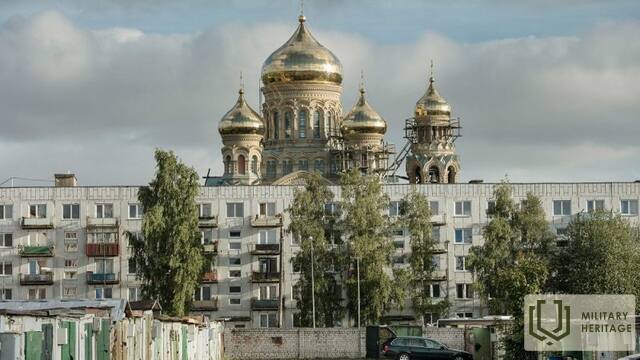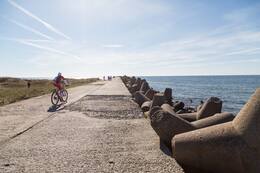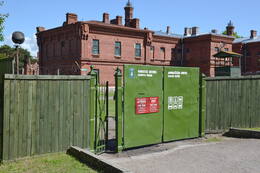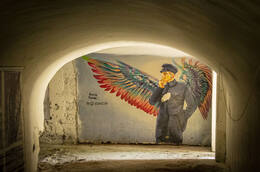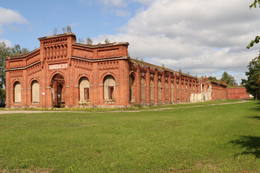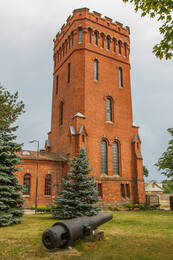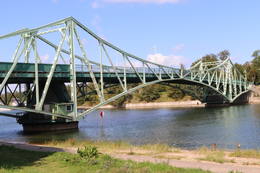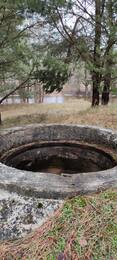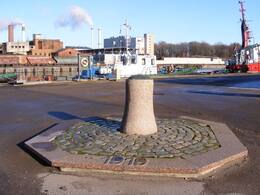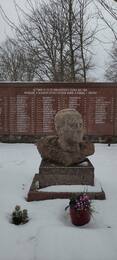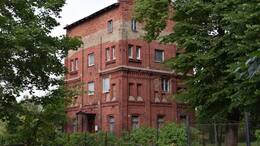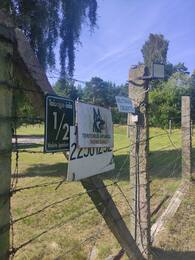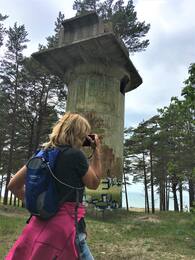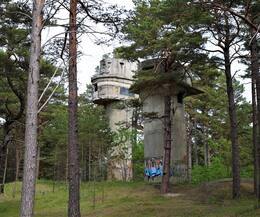Karosta in Liepāja
I World War I, I Wars of Independence, II World War II, IV Soviet Occupation, III National Partizans
Karosta is unique in the historical and architectural context not only in Latvia, but also the world.
Karosta is the largest historical military territory in the Baltics and occupies almost one third of the entire territory of Liepāja.
It was designed as a completely autonomous settlement with its own infrastructure, electric power plant, water supply, church and schools.
Karosta was built before World War I for the needs of the Russian army. During the Soviet period, Karosta was a closed territory, and not even the civilians of Liepāja were allowed in.
The last soldiers of the Soviet Army left Liepāja as late as in 1994.
The Karosta is home to military heritage sites such as the Northern Pier and Forts, Redan, Karosta Prison, Karosta Water Tower, St.Nicholas Orthodox Sea Cathedral, O.Kalpaka Bridge, etc.
SIGHTS IN THE KAROSTA:
St. Nicholas Maritime Cathedral is one of the symbols of the Karosta. It was built in 1903 as an Orthodox church, but during the Soviet occupation it housed the Matrose Club for a long time. Since the Red Army left, it has been an Orthodox cathedral again.
The North Pier protects the Liepaja harbour from north-westerly winds and is a popular place for walking and fishing. The length of the North Pier is 1800 metres.
The Redāns is part of Liepaja Fortress. The Liepaja Fortress (forts) was built in the 19th and 20th centuries. The forts were built at the turn of the 19th century with the aim of defending the Karosta and the whole city of Liepaja in case of an attack.
The Manege was once adorned with wide windows and a glass-tiled roof. It was used mainly for soldiers' exercise classes and ceremonial meetings.
The water tower towers 37 metres over the Karosta. It was built in the 20th century. The water tower was built in the early 1900s to provide the Karosta with fresh water.
The O.Kalpaka Turning Bridge connects the Karosta with the rest of Liepaja. The construction of the metal-structure bridge was completed in 1906 and since then it has undergone several reconstructions. Today, as in the past, the bridge is cut for ship traffic at certain times each day.
More information sources
War - YouTube
Karosta | LiepajaTravel
Related timeline
Related objects
North Pier and Battery No.3 in Karosta
The longest pier in Latvia - the Northern Pier - was built at the end of the 19th century as a very important part of the Liepaja Sea Fortress and military port. The length of the pier is 1800 metres, the width - 7.35 metres.
The Northern Pier is one of the first port structures of Emperor Alexander III, built between 1890 and 1892 before the excavation of the Karosta Canal. Together with the North Breakwater, the South Breakwater and the South Pier, the pier formed the outpost of Liepaja.
Liepaja Fortress Battery No 3 was located next to the North Pier of the Karosta and was planned to be the largest in terms of armament. Platforms were built for four 6-inch (152 mm) guns of the 1892 model of the Canet system, five 11-inch (280 mm) guns of the 1887 model and two 57 mm Nordenfeld anti-tank guns, as well as 18 9-inch (229 mm) guns and mortars.
Today, Battery 3 is most affected by the prevailing south-north sea current, which creates a whirlpool effect behind the North Pier, resulting in the washouts of the gun platform foundations.
The North Pier protects the Liepaja harbour area from North Westerly winds. It is a favourite place for residents and visitors to Liepaja to watch sunsets, fish and watch the sea in different weather conditions. Especially spectacular during storms.
There is ample parking at the North Pier. There are also restrooms and a café with a unique sea view.
The Redan, Karosta
Redans, or Redana Fort, is located in Karosta, 14. novembra Street, about 1.5 km from the Northern Forts, in the nature reserve "Tosmare".
Historically, redans were elements of fortifications where longer sections of fortress walls were divided into shorter sections by building V-shaped positions facing the enemy, which allowed for better protection of the fortification wall. Karostas Redan is a late 19th century Liepaja Sea Fortress, projecting towards Lake Tosmare. As the fortress lost its fortress role, the fortifications and forts around it were partially blown up and rendered unusable. However, Redan remained almost intact.
In November 1919, after the failure at Riga, Pavel-Bermont Avalov's forces launched an intensive attack on Liepaja. The battle was also fought at Redan, where 80 soldiers of the Liepaja Military Port Commandant's Office under the command of Lieutenant Commander Radzins fought. In a swift attack on 14 November, the Bermontians managed to take Redan. This was followed by a counter-attack by Latvian troops and Redan was retaken.
In June, July and August, a knowledgeable guide will be waiting at Redan every day from 11.00-17.00, ready to tell you more about Liepāja Fortress and the historical events in the Karosta.
Karaosta manège
The ruins of the Karosta manege are located in Karosta, at 2/12 Zemgales Street, between Zemgales, Burtnieku, Virssardzes and Manēžas Streets.
Until World War I, every Sunday the manege was used for cavalry, artillery and senior officers' sport horse demonstrations and on weekdays it was used for matrons' physical education classes. It was the largest covered hall in Liepāja, so it was also used for official receptions and meals of honour for the garrison matrons. In 1913, from 13 January to 26 April, the 300th anniversary of the reign of the Tsars Romanov dynasty was celebrated all over Russia. On 21 February 1913, the main event of the celebration was organised in the Liepaja garrison with a ball in both officers' meeting buildings (Naval and Infantry). A celebratory lunch was arranged for the officers at the Manege, where 4000 people were seated at tables at the same time.
The Manege was built between 1903 and 1904. Its distinctive feature was the roof - very light, with a riveted metal structure and a tin covering and strips of glass tiles. Together with the huge arched windows, it provided a large amount of light into the room. The hall was ascetic - the floor was covered with sawdust. The Manege suffered during the Second World War, when the entire roof structure was lost. After the war, the Soviet army began to use the arena as a car park and warehouse.
Today, only the walls of the manege can be seen, with the window openings bricked up during the Soviet years.
Karosta Water Tower
The water tower is located in Liepaja, in the Karosta, at 29 General Baloža Street - where the street meets Lazaretes Street. The water tower was an important building in the Karosta, as it supplied almost the entire Karosta area with drinking water. The exact time of construction of the water tower is unknown, but it could have been between 1903 and 1905. The project was probably designed by the St Petersburg architect Stefan Galenzovsky.
The water tower was powered by a steam engine with two coal boilers, one of which was kept in reserve, so there is an equally tall chimney next to the tower. The transmission powered four pumps, two of which were kept in reserve. Four boreholes supplied water to the pumps, which pumped it to a reservoir on the fifth floor of the tower and from there to the officers' apartments and soldiers' barracks in the Karosta.
When the Latvian Army took over the management of the water tower, the Ministry of War also took over the management of the water tower. After the Second World War, the Soviet Army took over the management. The water tower has been closed since 1989.
Although the tower was not a military building, in November 1919 the Latvian Army corrected the artillery fire of the British warships in the fight against the attack of the Bermont troops.
https://industrialheritage.travel/lv/objects/karostas-udenstornis/51
Karosta St.Nicholas Orthodox Sea Cathedral
The St Nicholas Orthodox Sea Cathedral is the visual and spiritual dominant feature of the Karosta, in stark contrast to the high-rise prefabricated housing built next to it. The church was designed and built according to the principle of 17th century Russian Orthodox churches, with one central and four side domes.
A representative cathedral was already envisaged at the time of the design of the port complex by Emperor Alexander III, but initially the port infrastructure took priority. A temporary Orthodox church was in operation from the beginning in the area of the port hospital.
Construction of the St Nicholas Maritime Cathedral began in 1900 to a design by the architect Vasily Kasyakov, which was very similar to other sacred buildings of the Russian Empire of the time. The cathedral was consecrated on 22 August 1903 and was attended by Emperor Nicholas II of Russia and his family. Until 1915, the cathedral hosted all the ceremonial events of the Russian army and navy, including the service of the 2nd Pacific Squadron in 1904 before it sailed to the Far East, where it was destroyed in the Battle of Tsushima.
After 1915, when Liepāja was occupied by German troops, the cathedral retained its sacred status and partly its furnishings, with rare services held there.
After the Latvian army garrisoned Liepāja in the territory of the Karosta, the cathedral continued to function as an Orthodox church until 1934, when it was converted into a Lutheran church for the Liepāja garrison. The church was redecorated, including the replacement of the crosses, and the three major denominations - Lutheran, Catholic and Orthodox - were able to hold services there. One Orthodox altar was retained in the cathedral, and in the late 1930s an electric organ manufactured in VEF was installed for Lutheran services.
During the Soviet military base in 1939-1941, the cathedral lost its sacred status, and during the Second World War the building was also used by various German units.
After the Second World War, the Soviet naval base authorities established a matrons' club in the cathedral and the building was converted to its new function.
In September 1991, while the Russian Federation was still in operation, the cathedral was restored to its historic name and handed over to the Orthodox Church. The first service was held on 19 December 1991 in honour of Saint Nicholas. In September 2016, the restored cathedral bells were consecrated.
Oskara Kalpaka Bridge in Karosta
The bridge named after Oskaras Kalpaka is Liepāja's gateway to the Karosta and is located at the meeting point of Oskaras Kalpaka and Atmodas Street - across the Karosta Canal.
The unique swing bridge was opened on 19 August 1906. The bridge was blown up during World War I, but was rebuilt after the war. The bridge was rebuilt again after it was damaged by the steamship Narne in 1926, but it also suffered during World War II when the invading Soviet army shelled the port of Liepaja. Until the restoration of independence of the Republic of Latvia, the Karosta was a closed area of Liepaja, inaccessible even to the inhabitants of Liepaja. The entire Karosta was a military facility, so traffic over the bridge was controlled around the clock by guard posts. Crossing the bridge to the Karosta was only possible with special permits for a few hours a day, the rest of the time the bridge was open to the traffic of Soviet warships. Throughout the years of occupation, the name of the bridge was "Red Army Bridge". In the summer of 2006, the Georgian-flagged tanker "Anna" flew into the northern abutment of the bridge, and after reconstruction, the Oskars Kalpaka Bridge was officially opened in August 2009.
The bridge weighs 300 tonnes and consists of two parts (North and South sides) made of two identical cantilevers. The bridge carriageway is 7.3 metres wide and its deck is made of wooden planks. The total length of the bridge is 133 metres with a span of 27.55 metres + 77.9 metres + 27.55 metres. The height of the bridge above water level is 8.32 metres. The bridge is cut at the appointed times and, in accordance with the Port Safety Regulations, a vessel shall only commence traffic when the bridge is open to vessel traffic and it is safe to enter or leave the Karosta Channel. The Oskars Kalpaka Bridge is turned back to vessel traffic 5 times a day. The bridge is not cut at the specified times if the wind speed exceeds 10 m/s or if no manoeuvres are planned.
Corporal Narkēvic's trench
The excavation restored by Corporal Narkēvics is located in the immediate vicinity of the Cietokšņa Channel and can be viewed both separately and along the Karosta Freedom Trail.
The site of the trench from which Latvian Army Corporal Vilis Narkēvics guarded the Šķēde Bridge using a rifle (light machine gun). Corporal Narkēvičs was armed with a 7.69 mm calibre Lewis assault rifle (light or hand machine gun) purchased from the British. With 97 rounds loaded in the magazine, it was a heavy (almost 12 kg) but effective weapon. Corporal Vilis Narkēvics' experience gained on the World War fronts and his accurate machine-gun fire won the battle. He was awarded the Military Order of the Order of the Knights of the Latvian Armed Forces.
NBS soldiers and servicemen restored Corporal Narkēvics' position in April 2017.
Liepāja Northern Fort and Battery Nr.1 in Karosta
The Northern Forts are the best known and visually most impressive part of the Liepāja Fortress. Built by the Russian tsarist army in the late 19th century, their historical name is Fortress Battery No 1.
In November 1908, less than 10 years after its construction, the Liepāja Fortress ceased to operate, because its construction was acknowledged as a strategic mistake. Some of the cannons were dismantled and taken to the Kaunas Fortress in Lithuania, while others were remelted. Fortification structures were detonated twice in an attempt to destroy the fortifications. Elements surviving to the present day include artillery batteries not fully destroyed in the explosions and underground structures. Just like the Karosta, the Northern Forts were a closed military territory during the Soviet occupation. Visitors to the Northern Forts should be very careful. As in other places on the Latvian coast, the steep shore of the Baltic Sea in the Karosta is dangerous due to potential coastal landslides. Therefore, it is not allowed to walk under the ruins of the forts.
In the northern part of the fortress was located one of the four coastal defence batteries, Battery No.1. The battery was to house six 6-inch (152 mm) guns of the 1892 model of the Canet system, six 11-inch (280 mm) guns of the 1887 model and two 57 mm Nordenfeld anti-ship guns. Only the guns of the Canet system had a long enough firing range to withstand possible shelling by the German Navy. Thus, at the time of the liquidation of the fortress, the armament was only partially installed.
Freedom Trail (Karosta route)
A well-maintained, 9 km long walking trail created to commemorate the bravery and heroism of Latvian men during the Latvian Freedom Struggle in 1919.
The trail starts in Redana and runs through the forest area of Karosta, along the seashore and the Cietokšņa Canal, including a visit to the Tsarist-era fortifications and Soviet-era military heritage. The trail features 5 information boards, which introduce the creation of the Karosta and the fortification system that encircles the entire city, the 1919 Battle of Freedom in Liepāja, the military structures built in later years and life in the Karosta during the Soviet era.
On 18 November 1918, the independent Republic of Latvia was proclaimed, but several foreign troops were still stationed on the territory of the newly established Latvian state.
The Battle of Liepaja in November 1919 played an important role in Latvia's regaining its freedom, when, thanks to the heroism of the soldiers, the enemy was outnumbered almost 5 times. After the decisive battles in Liepaja, Bermont was driven out of Latvia
Berth of the ship "Saratov" in Liepaja
The berth of the "Saratov" is located in Liepaja, at 59 Old Harbour, near the boat docks.
Built in 1888 in Copenhagen by the shipyard Buvmeistar & Wain under the name "Leopold II", in 1911 it was bought by the joint-stock company Russian North-West Shipping and renamed "Saratov", with the Latvian Aleksandrs Remess becoming the ship's captain.
In May 1915, when Liepaja was occupied by German troops, the Saratov was in a damaged state in the harbour.
On 10 January 1919, the steamship Saratov was taken over by the Latvian Provisional Government. From April to July 1919, after the "16 April coup d'état", the Provisional Government headed by K. Ulmanis was on board the Saratov and was forced to take refuge under the protection of the Allied fleet.
On 8 July 1919, after the delivery of the Provisional Government of K. Ulmanis to Riga, the steamers were used for traffic between Riga, Ventspils and Liepaja.
Under the terms of the Peace Treaty of 11 August 1920 between Latvia and Soviet Russia, the steamship Saratov had to be returned to the Soviet side. On 2 January 1923, the steamship was handed over to a Soviet Russian representative. On 15 January 1923, the steamship "Saratov" was wrecked off Akmenrags.
In 1936 the Latvian Maritime Department sold the wreck to a company, which scrapped it and handed it over to the Liepaja Cloth Factory.
Monument to the dead fishermen and sailors and US airmen
250 metres south-west of Battery 6 is the Monument to Fishermen and Sailors, with a plaque to the US Navy PB4Y-2 Privateer scout plane shot down off Liepaja on 8 April 1950. The aircraft, nicknamed Turbulent Turtle, was part of Patrol Squadron 26 and took off from Wiesbaden airfield in the early hours of 8 April and, via Copenhagen, set off on a surveillance and possibly radio reconnaissance mission. According to the order, the aircraft could not approach closer than 20 nautical miles to the Kurland coast, but for some unknown reason it flew into the USSR's self-defined 12 nautical mile zone. Two La-11s of the Soviet 30th Guards Fighter Regiment intercepted and shot down the unarmed reconnaissance aircraft. The fate of the 10-strong crew of the downed aircraft is not known with certainty; there is conflicting information that all were killed or, alternatively, that some of the pilots survived and ended up in prisoner-of-war camps.
The crew:
AT1 Frank L. Beckman
AL3 Joseph J. Bourassa
ENS Tommy L. Burgess
AD 1 Joseph H. Danens
LT John H. Fette
CT3 Edward J. Purcell
LTJG Robert D. Reynolds
AN Joseph N. Rinnier
LT Howard W. Seeschaf
AD 1 Jack W. Thomas
Monument to the dead fishermen and sailors and US airmen
250 metres south-west of Battery 6 is the Monument to Fishermen and Sailors, with a plaque to the US Navy PB4Y-2 Privateer scout plane shot down off Liepaja on 8 April 1950. The aircraft, nicknamed Turbulent Turtle, was part of Patrol Squadron 26 and took off from Wiesbaden airfield in the early hours of 8 April and, via Copenhagen, set off on a surveillance and possibly radio reconnaissance mission. According to the order, the aircraft could not approach closer than 20 nautical miles to the Kurland coast, but for some unknown reason it flew into the USSR's self-defined 12 nautical mile zone. Two La-11s of the Soviet 30th Guards Fighter Regiment intercepted and shot down the unarmed reconnaissance aircraft. The fate of the 10-strong crew of the downed aircraft is not known with certainty; there is conflicting information that all were killed or, alternatively, that some of the pilots survived and ended up in prisoner-of-war camps.
The crew:
AT1 Frank L. Beckman
AL3 Joseph J. Bourassa
ENS Tommy L. Burgess
AD 1 Joseph H. Danens
LT John H. Fette
CT3 Edward J. Purcell
LTJG Robert D. Reynolds
AN Joseph N. Rinnier
LT Howard W. Seeschaf
AD 1 Jack W. Thomas
Liepaja Fortress South Fort and monument to N. Dedaev, commander of the 67th Rifle Division of the Red Army
The South Fort of Liepaja Fortress is located in the south-western part of Liepaja, between Klaipėda Street and the beach.
A fort was planned to protect the port of Emperor Alexander III from the south, two kilometres from the southern border of the city. The fort was to be located between Liepāja Lake and the sea, west of the outlet of the Thunder River, reinforcing the reinforced concrete fortifications with a moat. Although the fortifications were almost completely finished, the armaments had not been deployed. The constructed cellars were used as storage facilities both during the First World War and during the Second World War. In the 1920s and 1930s, various factories were located in the fortification area. Unlike the Middle Fort and Ravelin, the South Fort never took part in the war, because in all the wars the invaders besieged the eastern shore of Lake Liepāja and tried to invade Liepāja between Lakes Tosmare and Liepāja.
To the north of the South Fort is Liepāja's largest cemetery, the Central Cemetery. In the southern part of the cemetery there is a Red Army cemetery where Soviet soldiers who died in the vicinity of Liepāja are reburied, including the commander of the 67th Rifle Division, Major General Nikolai Dedaev, who led the defence of Liepāja in June 1941.
Pigeon post sea station in Karosta
The former naval pigeon station No.2 - actually a breeding station - is located in Karosta, Pulkveža Brieža iela 6. It was built between 1899 and 1900 and was intended to house about 450 carrier pigeons - winged soldiers. In later years, the building was converted into apartments, so that only the red brick volume of the building remains. The other post pigeon station, No 1, which has not survived, was intended for the use of 750 ground troops and was located at the northern end of Atmodas Boulevard.
The carrier pigeons were a simple, fast and reliable way to ensure communication between the shore and ships at sea. Although the radio telegraph, as a modern communication device, was already widely used at that time, the use of pigeons was considered safer - an enemy could only intercept a message by intercepting the carrier pigeon itself. The carrier pigeons moved at an average speed of 60 km per hour, but in favourable wind conditions they could move at speeds of up to 100 km per hour. Pigeons had to be specially prepared and trained, so handling them required care and patience. The homing pigeon's communication worked through the birds' ability to return to their home cage. When the bird was transferred to another location - a pigeon station, release and release point - and released with a message capsule, the little messenger returned to its home cage. In order to ensure communication between the two pigeon stations, it was necessary to keep a certain number of birds in each, which had grown up in the correspondent's communication, or carrier pigeon, station. Each year the pigeons were involved in various manoeuvres and competitions. Also after Latvia's independence, from 1920 to 1940, an army carrier pigeon station was located in Liepāja for the Latvian Army's Courland Division, which was able to communicate with both Riga and Daugavpils. During the inter-war period, stray communication pigeons from Germany, Poland, Lithuania, Finland and Estonia also wandered into Latvian territory. Pigeons from Latvia were also suddenly found in neighbouring countries.
The building has been rebuilt several times over the years and is now a residential building. But the distinctive shape of the building, made of the red bricks characteristic of the old buildings of the Karosta, is still clearly visible from the outside.
Liepāja Coastal Artillery Battery No. 2
Among the many objects of the Liepāja Naval Museum, the Liepāja Coastal Artillery Battery No. 2 is still the most mysterious place in Liepāja. Battery No. 2 was invariably equipped with ammunition depots for the troops of various existing powers.
Liepāja Fortress Battery No. 2 was built further from the coastline and was protected by a high fortification wall. The battery was armed with 16 11-inch (280 mm) mortars of the 1877 model. After the fortress was dismantled, ammunition depots were set up here. Due to the explosive hazard, the territory was closed to the public for 130 years, a guarded area, but now an exhibition has been set up here about the activities of the 1st Courland Division Headquarters in 1919-1940, as well as photographic evidence of the 1st Liepāja Infantry Regiment, the 2nd Ventspils Infantry Regiment and the Courland Artillery Regiment.
Rangefinder No.1 of the 23rd Shore Battery (1941)
The rangefinders (dating from 1941) are located in the pines of the dune, only 10m from the other tower, built in 1954. The 1st and 2nd gun emplacements of the shore battery are located on the seafront and partially eroded, while the 4th gun emplacement is best seen in the dunes. The reinforced concrete bunker of the personnel who manned the guns is now washed away by the waves and has a washed-out foundation, tilted and leaning seawards.
Liepaja Fortress Battery 2 was planned to be built further from the shoreline and protected by a high rampart. The armament of the battery was to be 16 11-inch (280 mm) mortars of the 1877 model. The mortars used steep trajectories and did not require direct aiming.
Following the 'base agreement' between the Republic of Latvia and the USSR, signed on 5 October 1939, a contingent of nearly 25 000 Red Army and Baltic Navy troops was to be stationed in Kurzeme. By March 1941, Baltic naval bases were established in Latvia in the defence sectors of Irbe Bay, Saaremaa and Liepāja, consisting of coastal defence batteries.
The Liepaja coastal defence sector included the 208th artillery division with two 130 mm B-13 gun batteries (No 23 and No 27) and one 180 mm rail gun battery. Construction of Battery 23 began in November 1939 and was completed on 17 May 1941, partly using the reinforced concrete fortifications of Battery No. 2 of Liepaja Fortress. Battery 23 consisted of four reinforced concrete gun positions on the seafront, a command post and an observation (range-finding) tower in the dune forest. The range-finding positions were located in reinforced concrete towers to ensure better visibility while maintaining concealment in the pine forest.
After the Second World War, Battery 23 was renamed Battery 636, armed with the same 130 mm B-13 guns, and a new range-keeping tower was built for fire control in 1954, adjacent to the 1941 tower. In 1963, all the Liepaja coastal defence guns were dismantled.
After the restoration of Latvia's independence, the area of Battery No 2 is in the use of the Ministry of Defence.
Rangefinder No.2 of the 23rd Shore Battery (1954)
The rangefinder (dated 1954) is located in the pines of a dune 10m away from the 1941 rangefinder. The gun positions of the 1st and 2nd guns of the shore battery are located on the seafront and partially eroded, while the gun position of the 4th gun is best seen in the dunes.
Liepaja Fortress Battery 2 was planned to be built further from the shoreline and protected by a high rampart. The armament of the battery was to be 16 11-inch (280 mm) mortars of the 1877 model. The mortars used steep trajectories and did not require direct aiming.
Following the 'base agreement' between the Republic of Latvia and the USSR, signed on 5 October 1939, a contingent of nearly 25 000 Red Army and Baltic Navy troops was to be stationed in Kurzeme. By March 1941, Baltic naval bases were established in Latvia in the defence sectors of Irbe Bay, Saaremaa and Liepāja, consisting of coastal defence batteries.
The Liepaja coastal defence sector included the 208th artillery division with two 130 mm B-13 gun batteries (No 23 and No 27) and one 180 mm rail gun battery. Construction of Battery 23 began in November 1939 and was completed on 17 May 1941, partly using the reinforced concrete fortifications of Battery No. 2 of Liepaja Fortress. Battery 23 consisted of four reinforced concrete gun positions on the seafront, a command post and an observation (range-finding) tower in the dune forest. The range-finding positions were located in reinforced concrete towers to ensure better visibility while maintaining concealment in the pine forest.
After the Second World War, Battery 23 was renamed Battery 636, armed with the same 130 mm B-13 guns, and a new range-keeping tower was built for fire control in 1954, adjacent to the 1941 tower. In 1963, all the Liepaja coastal defence guns were dismantled.
After the restoration of Latvia's independence, the area of Battery No 2 is in the use of the Ministry of Defence.
Related stories
About the cannons of the Liepāja Fortress
In the northern part of the fortress was located one of the four coastal defence batteries, Battery No.1, but at the time of the fortress's liquidation its armament was not fully installed.
The story of the O. Kalpakas Bridge
In its more than 100 years of existence, the bridge has survived two wars and different owners, which have affected its operation. The bridge was blown up during World War I, but was rebuilt after the war, only to be damaged again in 1926 by the steamship Narne. The bridge was rebuilt again, but it also suffered during World War II when the invading Soviet army shelled the port of Liepaja.
Soviet air raids on the Liepāja suburb in October and December 1944
At the end of World War II, the German forces in Courland were able to successfully defend themselves for seven months, as the German Navy maintained combat capability until the end of World War II and supplied Army Group North and later Army Group Courland. The main port was Liepaja, through which 80% of all cargo was delivered and shipped. Liepaja thus became an important target for the Soviet Baltic Navy and long-range aviation.
Wounding of Major General N. Dedayevs at the Liepāja Fortress, Vidus Fort
In June 1941, the successful attack of the German army had reached Liepaja, when Liepaja was attacked by the 291st Infantry Division of the German Armored Forces. When hostilities between Nazi Germany and the Soviet Union began in June 1941, the Liepaja garrison of the Soviet Army consisted of troops from the Liepaja naval base of the Navy and the Red Army. During these battles Major General N.Dedaev was mortally wounded
Battle of Redan in November 1919
Donāts Pudulis was a sergeant of Liepaja Military Port Commandant's Office, who received the Order of the Battle of the Battle of the Bulge for bravery and valour on 14 November 1919, when after the enemy attacked Redāns Fort, he took over the command of the commandant's company from the mortally wounded Lieutenant Commander Robert Radziņš and in a swift counterattack drove the enemy out of the fort, taking 8 prisoners and 2 working machine guns. His life up to the Battle of Liepaja is interesting. He volunteered for the Siberian Rifle Regiment in 1911 at the age of 16. In 1914 he took part in the battles against the German army at Warsaw, Lodz and elsewhere on the Polish front, and later in the battles against the Austrian army. In 1915 he sailed to France via Vladivostok as part of the Russian Expeditionary Corps and fought for 4 months at Verdun. At the beginning of 1917 he joined the Latvian Rifle Regiments, and on 7 April 1919 - the Latvian Armed Forces in Liepaja.
Karosta – the landing site of a German He-111 on the beach of Liepāja in 1939
On 11 September 1939, a German Henkel He-111 bomber was raiding Polish cities when it went off course at night and made an emergency landing on Liepāja beach. This event is recounted in the memoirs of Vilis Zobens, a Liepaja resident and a liaison company officer of the Kurzeme Division. The landing site is not marked in nature. The approximate coordinates are N 56.59368° E 21.01598° - on the beach near the Northern Forts.
Liepāja - at the crossroads of various historical events
The inhabitants of Liepāja were among the first in Latvia to experience the outbreak of the Second World War and among the last for whom the war ended both literally and symbolically. The Second World War and the Soviet occupation of Liepāja ended only in 1994, when the last troops of the USSR's heir, Russia, left the city.
Reasons for awarding the award to Commander of the Armoured Train A.Klestrov
After successfully repelling an enemy attack, the commander of the armed train A.Klestrov falls and Colonel Danker issued the grounds for the award
The miraculous escape of Lieutenant-Colonel Eduards Graudins from being shot
In November 1944, a court-martial of the German occupation authorities sentenced 8 staff officers of General Kurel's group, three staff officers were pardoned for various reasons. The lieutenant colonel managed to escape from being shot, but Graudiņš was "trampled" by the German concentration camp system
The story of a unique military facility in Karosta
For years, I have not noticed any sustained interest in the unique places just eight to ten kilometres north of the city centre among the residents of Old Liepaja. But hidden in the thicket of the forest, on the dune bank or on the marsh paths, the historic sites of the Karosta are no less interesting historical facts and stories worthy of long-forgotten legends. One of them - the former 23rd Coastal Artillery Battery of the USSR - will be the subject of this story.




